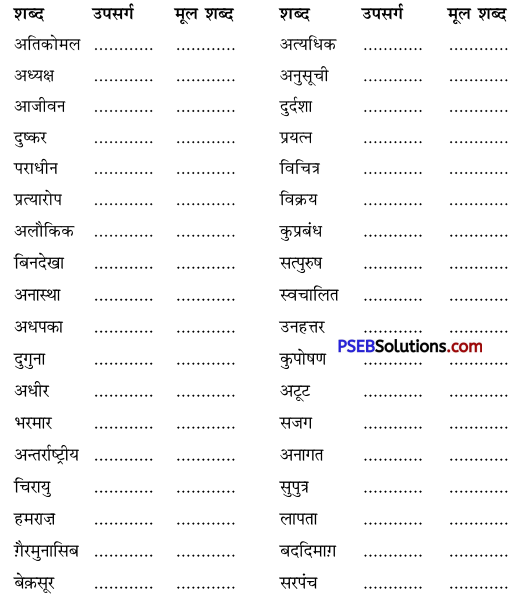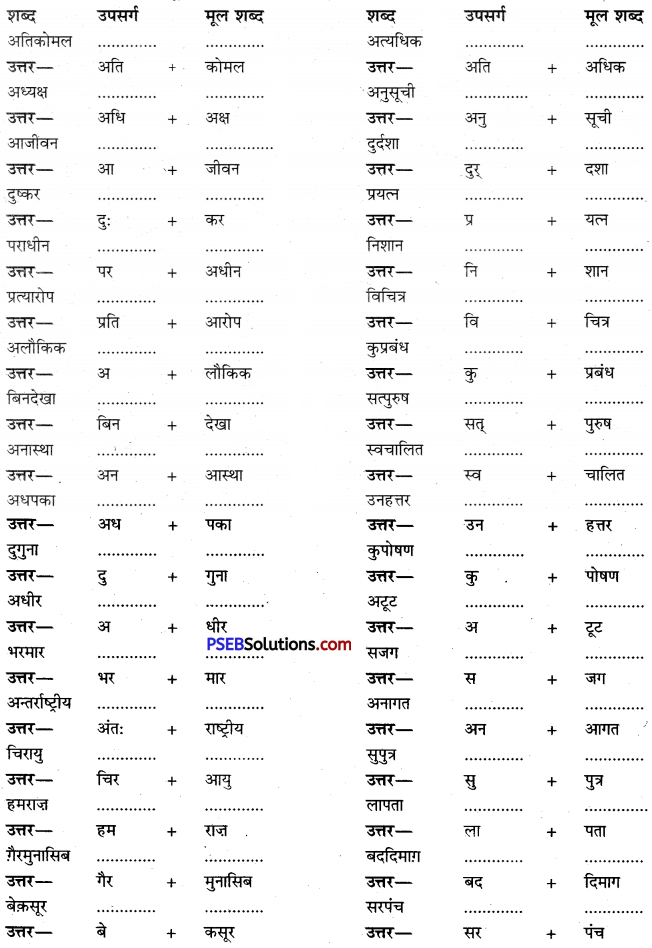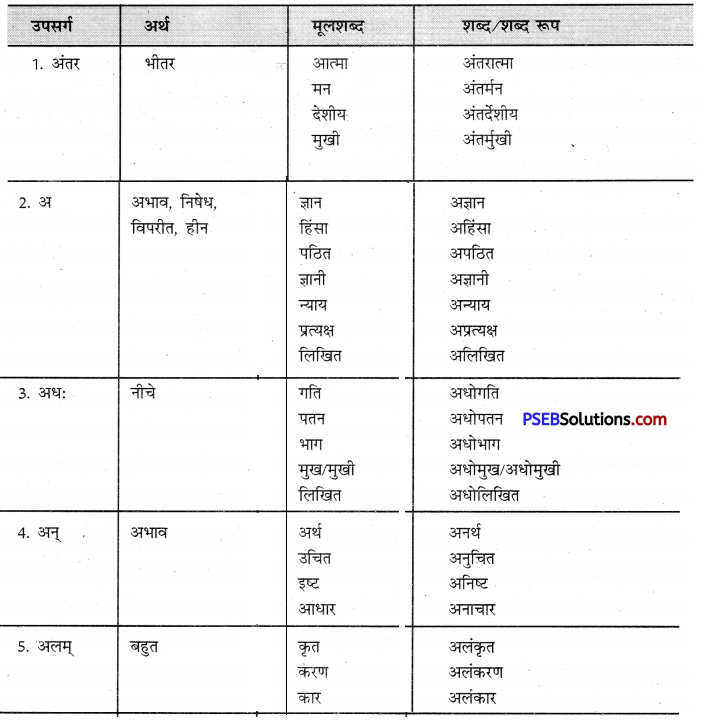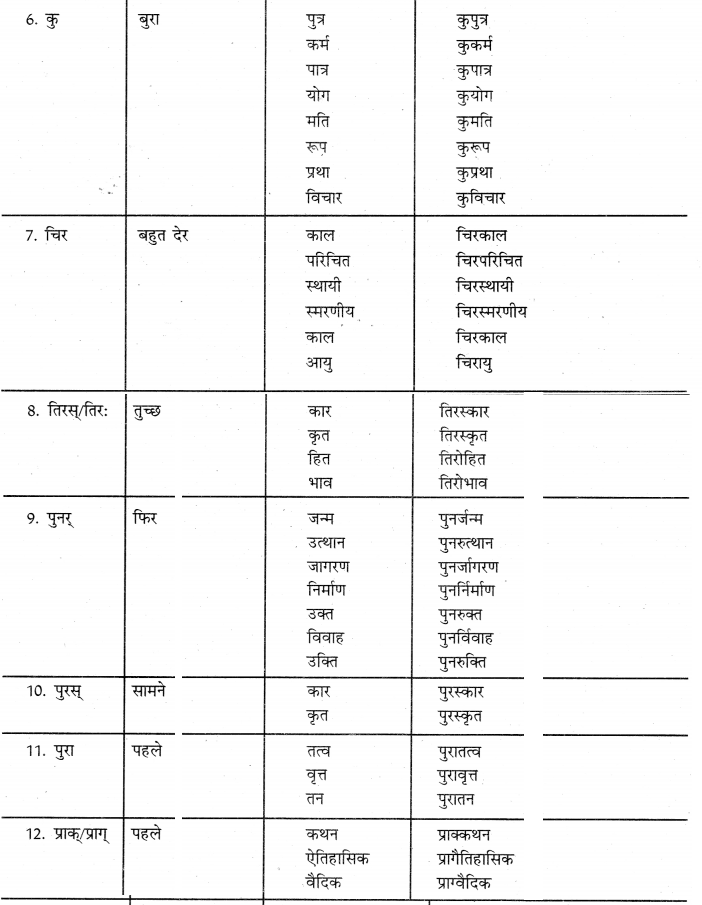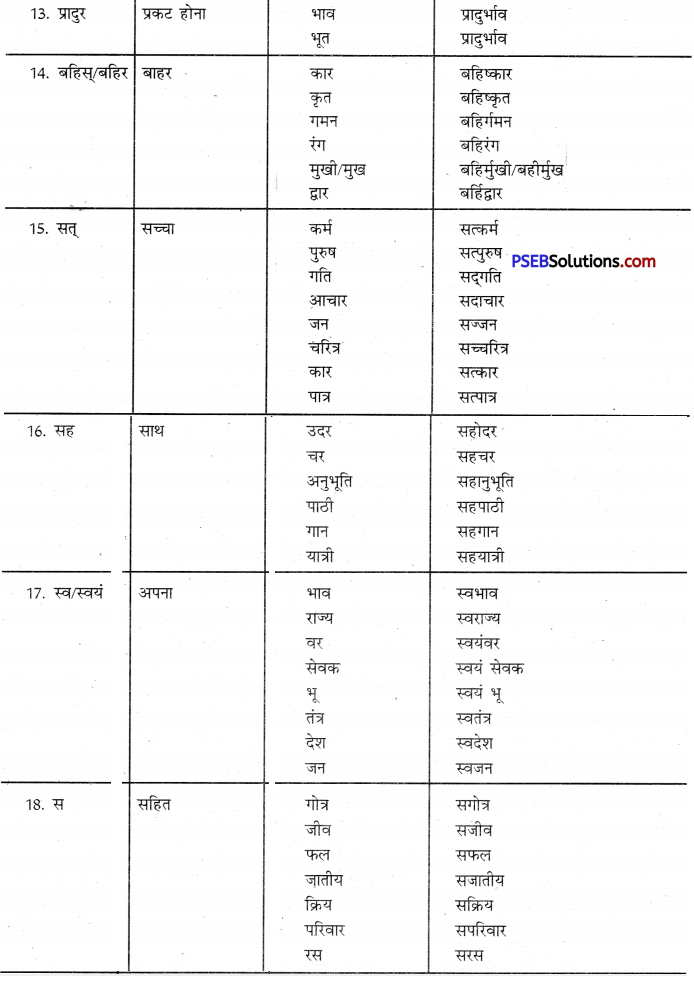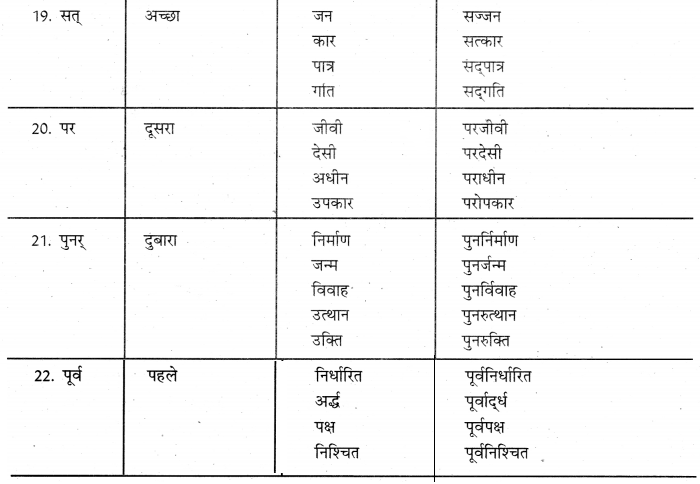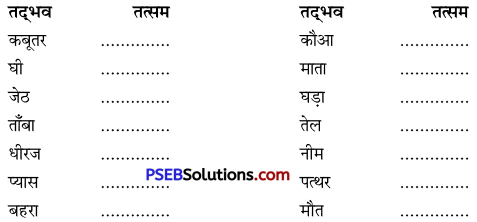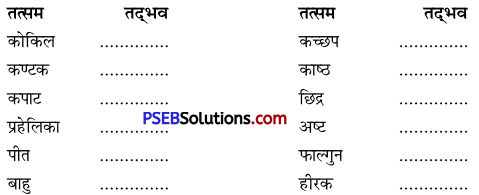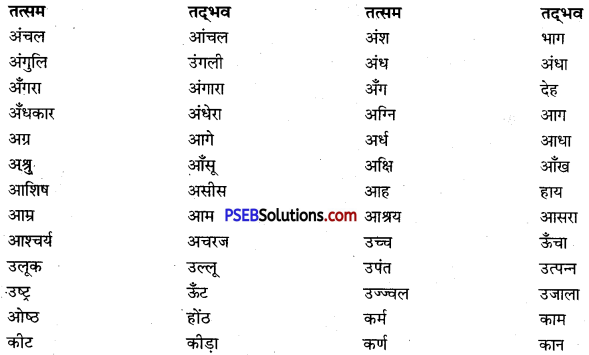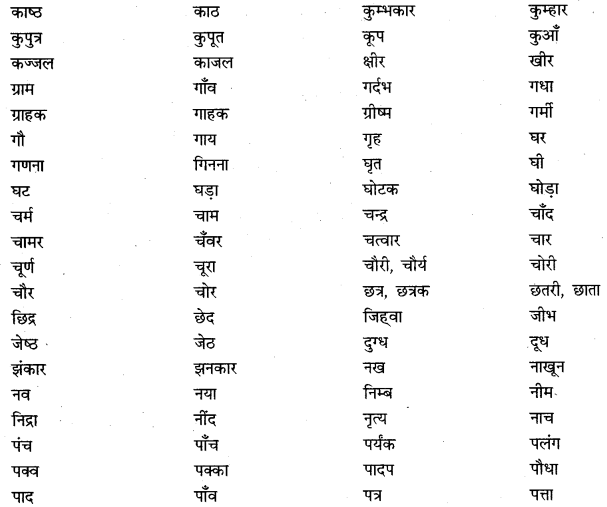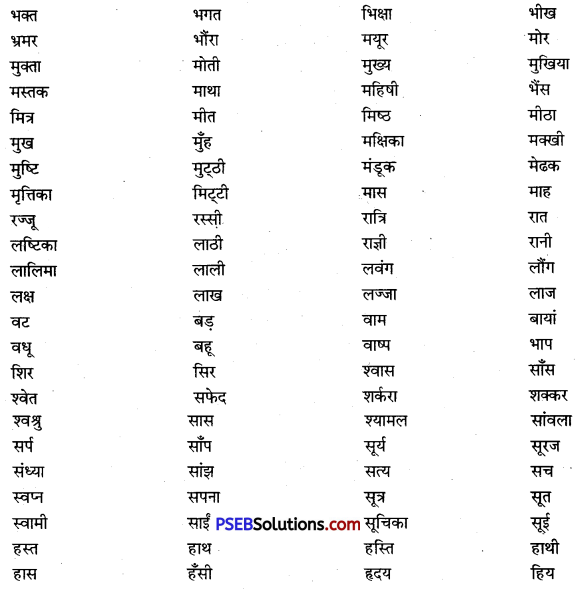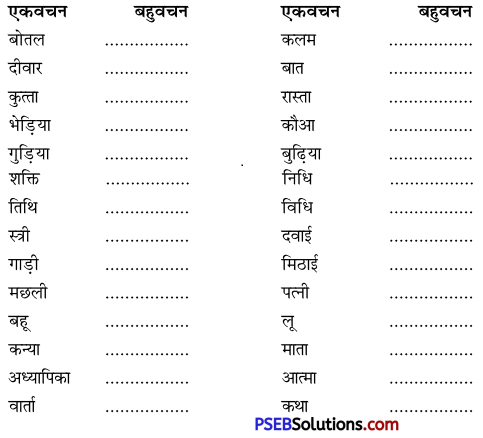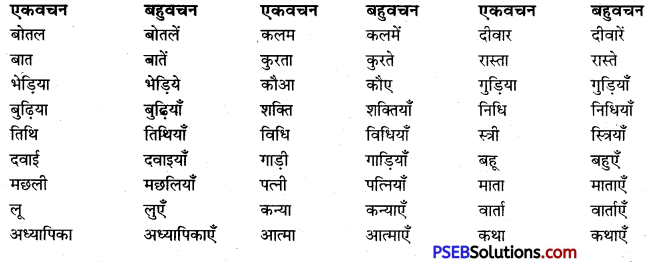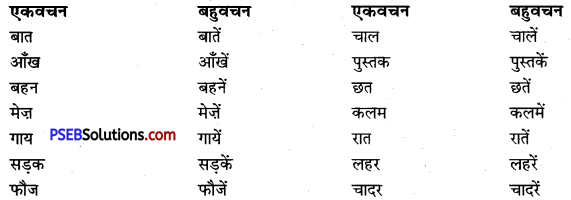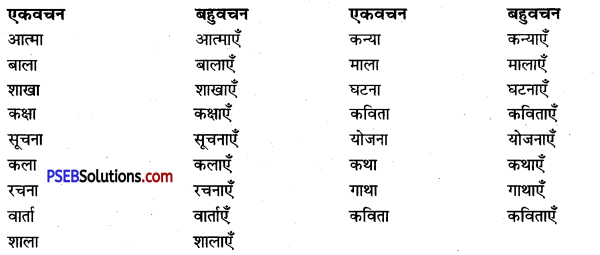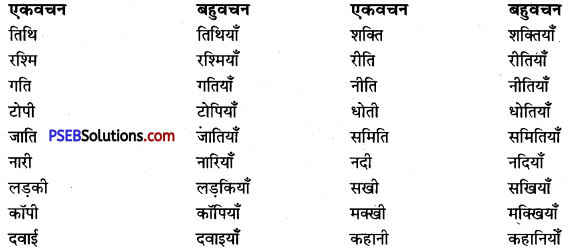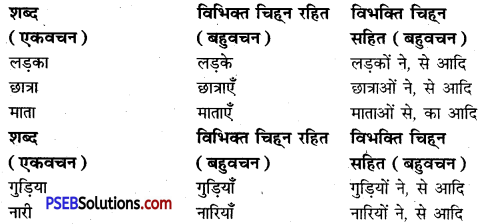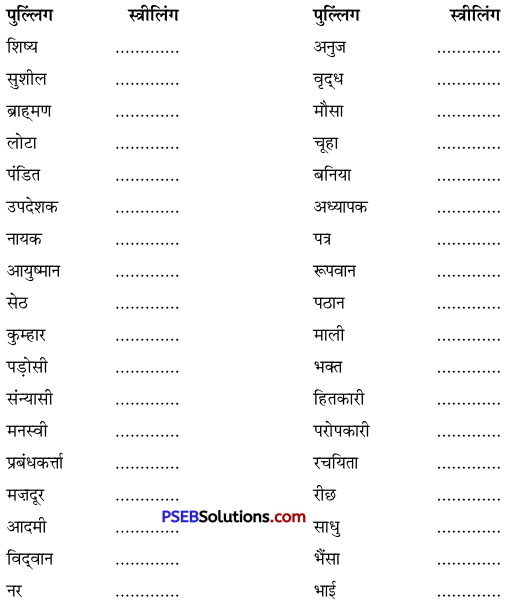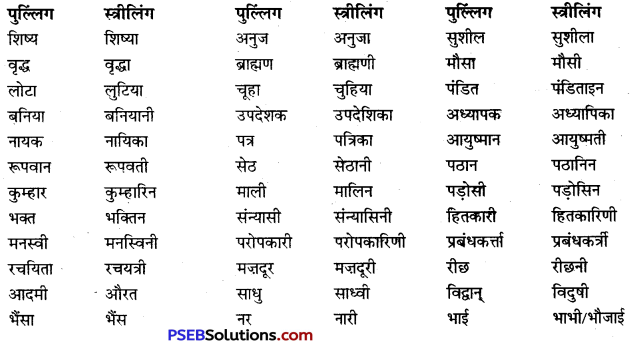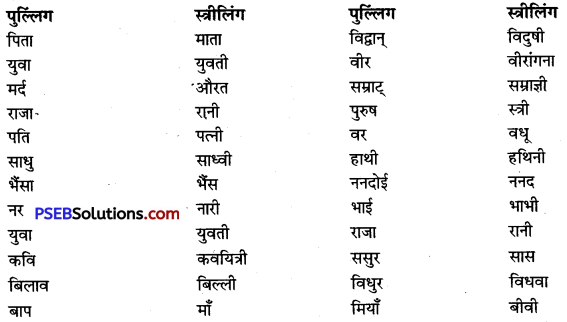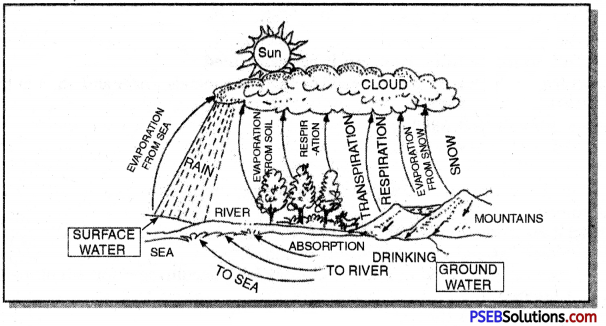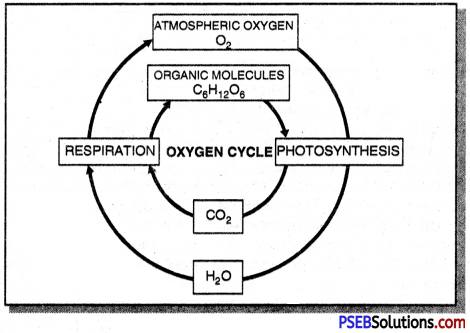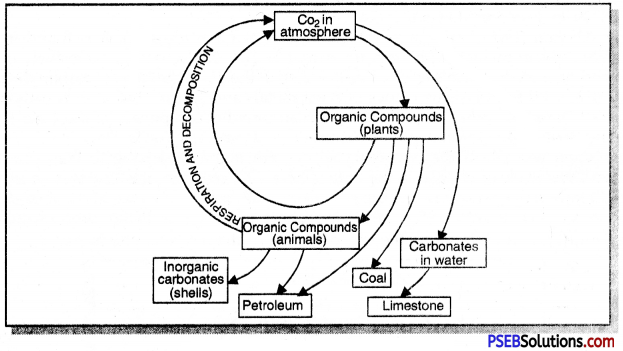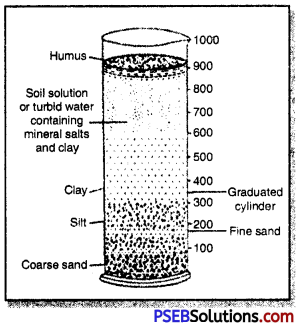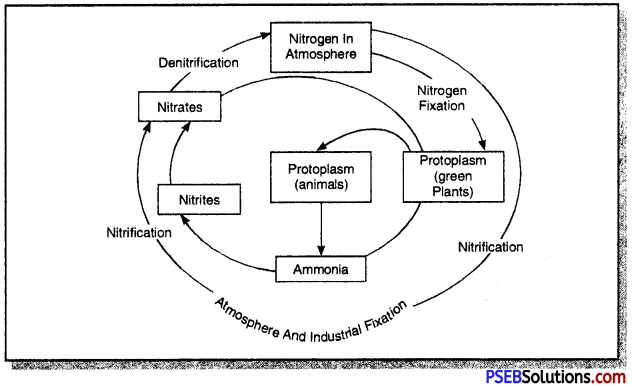Punjab State Board PSEB 9th Class Science Important Questions Chapter 15 Improvement in Food Resources Important Questions and Answers.
PSEB 9th Class Science Important Questions Chapter 15 Improvement in Food Resources
Long Answer Type Questions:
Question 1.
How to meet the needs of ever-increasing population of our country? List two main steps. Give in a tabulated form some of the crops grown in India.
Answer:
The present population of 1.21 billion people will reach about 1.343 billion people by the year 2020. This population will need about 241 million tonnes of grain production per year. Following two measures will help up to meet the demand.
1. Increase food production of both plants and animals.
2. Sustainable agriculture where by we should minimize using chemicals as fertilizers and insecticides. These can be replaced by biological resources.
Some crop plants grown in India:
| Type |
Some Examples |
| Cereals or grain crops
Fibre crops
Pulses
Oil seeds
Fodder crops
Root crops
Tuber crops
Sugar crops
Plantation crops
Products from animals |
Rice, Wheat, Barley, Ragi, Maize, Jowar, Bajra.
Jute, Cotton, Hemp, Coir.
Grams, Peas, Beans, Masoor, Mung.
Mustard, Groundnut, Sunflower, Coconut, Taramira. Barseem, Oat, Sudan grass.
Sweet potato, Carrot, Radish, Beet.
Potato, Tapioca.
Sugarcane, Beetroot.
Coffee, Tea, Rubber, Coconut.
Fish, Egg, Milk, and Meat. |

Question 2.
How is manure prepared?
Answer:
Method of preparing compost manure:
Manure is a natural organic substance obtained by decomposition of animal wastes and plant residue through the action of microbes. It is of three types
1. Farmyard manure
2. Compost
3. Green manure.
- A trench having the desirable size of 4-5 m long, 1.5 to 1.8m broad with a depth of 1.0 to 1.8 m is made.
- A layer of about 30 cm in thickness containing well mixed refuse is spread in the trench.
- This layer is sprayed with water containing slurry of cow dung.
- Another layer of mixed refuse in trench up to the height of 45-60 cm (height of fish layer included).
- Top of these two layers is covered by thin layer ot earth.
- After a gap of about three months, material is taken out of trench, moistened with water and covered with earth.
- Compost is ready for use after gap of 1-2 months.
Question 3.
Differentiate between manures and fertilizers.
Answer:
Differences between manures and fertilizers:
| Manure |
Fertilizers |
| 1. Manures are partially decayed wastes and animal residues by microbes.
2. Organic substances.
3. Voluminous, bulky, difficult to store and transport.
4. Not very rich in minerals like N, P and K.
5. Contain all nutrients, although in small amount.
6. Slow absorption, being less soluble in water.
7. Plenty of humus is added to soil and improves the texture of soil. |
1. Fertilizer is a salt or organic compound containing essential plant nutrients.
2. Inorganic salts or organic compounds.
3. Compact, can be easily stored and transported.
4. Rich m minerals like N, P, K.
5. Specific. Every fertilizer contains one or more nutrients.
6. Rapid absorption due to easy solubility in water.
7. Humus is not added to soil. |
Question 4.
What is mixed cropping? Discuss the advantages of mixed cropping.
Answer:
Mixed cropping is growing of two or more crops simultaneously on the same piece of land.
Objectives of mixed cropping:
- To minimise risk and insure against crop failure.
- To reduce cultivation expenses.
- To provide balanced nutrition to farmer and his family.
Advantages:
- It acts as insurance against possible total crop failure in poor rainfall areas.
- It saves time and labour of the farmer.
- It provides different types of food materials.
- Thus, farmer and his family can get balanced nutrition.
Some of the prominent mixed cropping practices:
- Maize + urdbean
- Cotton + mungbean
- Groundnut + sunflower
- Wheat + chickpea
- Wheat + mustard

Question 5.
Define livestock. Classify the cattle on the basis of their utility and give one example of each.
Answer:
Livestock includes domesticated animals like cows, buffaloes, sheep, goats, pigs, horses, etc. Cattle and buffaloes are most important livestock animals. These are used in agricultural operations and transportation though also provide milk, meat, hides (for leather goods), dung manure and fuel (in biogas plants). There are 30 breeds of cows and 10 breeds of buffaloes in India.
- Milch breeds: Milk-yielding varieties of cows but their males are not useful as working animals e.g. Gir, Sahiwal, etc.
- Draught breeds: Their males are used as beast of burden and good work animals but their cows are poor milk-yielding e.g. Malvi, Hallikar, etc.
- Dual-purpose breeds: Their cows are good milk-yielding while their males are good Work animals and help in agricultural operations e.g. Haryana, Tharparkar, etc.
Indian breeds of cows and buffaloes
1. Cows:
(a) Milch breeds:
- Gir
- Sahiwal
- Red Sindhi
(b) Draught breeds:
- Malvi
- Nageri
- Hallikar
- Kangayam
2. Buffaloes:
- Murrah
- Mehsana
- Surti
- Nili Ravi
Buffalo milk is richer in fat, tocopherol, proteins, calcium, phosphorus and contains low sodium, potassium, cholesterol. Buffalo milk is ideal for making milk products like khoa, rabri, dahi and ghee.
Question 6.
What is the need of proper shelter to cattle? List the characters of a good animal shelter.
Answer:
Shelter to Cattle: A good animal shelter not only increases the milk-production but also improves the health of animals.
A good animal shelter has following characteristics:
(a) It should provide protection to the animals from unfavourable environmental factors and predators.
(b) It should be clear, dry, airy, spacious and well ventilated (proper sunlight).
(c) It should have arrangement for the hygienic disposal of animal excreta.
(d) It should have arrangement for clear drinking water for animals.
(e) It should have hygienic conditions to protect the animals from various diseases.

Question 7.
What are additive feeds for cattle? How can one detect that an animal is sick?
Answer:
The cattle feed consists of two main components i.e. roughage and concentrate. However high yielding cows require more feed. Dairy animals require minerals and antibiotics and they are commonly called additive. Additive feed performs following functions:
1. Protects the animals from diseases.
2. They enhance milk yield.
3. Promote growth of the animals.
Symptoms of detection of sick animals:
- Laziness, tired and prefer to stay alone.
- Stop feeding or take a very little feed.
- Walks very slowly.
- Fall in milk or egg production.
- Waste passed out is dilute.
- Rise in temperature with shivering and sneezing.
- Secretion of excess of saliva.
Question 8.
Write a short note on variety improvement of poultry farming.
Answer:
Variety Improvement of Poultry Farming. It involves cross-breeding of indigenous varieties with exotic breeds. The improved varieties are developed for the following desirable traits:
- Quality and quantity of chicks.
- Dwarf broiler parent for commercial chick production.
- Summer adaptation capacity/tolerance to high temperature.
- Low maintenance requirements.
- Reduction in the size of the egg-laying bird with ability to utilise more fibrous cheaper diets formulated using agricultural by-products.
Question 9.
What steps should be taken to improve production of food from animal sources in our country?
Answer:
- Introduction of high-yielding varieties.
- The output of research work carried out at various centres such as NDRI Kamal, Central Institute of Fresh Water Aquaculture (CIFA) Bhubaneshwar, should be made available to the public for their projects.
- Protection of animals from diseases.
- Providing proper shelter to animals.
Question 10.
What are the practices adopted to improve crop production?
Answer:
The practices adopted to improve crop production are as follows:
- Fertilizers: These are the chemical compounds which are added to the soil to increase the fertility. They make up for the deficiency of the required nutrients and help in increasing the crop production.
- Selective Breeding: Disease-resistant seeds are produced by selective breeding. Regular use of high yield variety results in better crop production.
- Weed Control: The unwanted plants or weeds are controlled by using certain chemicals called weedicides.
- Control of Plant Diseases: Crops should be protected from insects, fungi, animals and other diseases.
It is very useful for increasing crop production. Insects are very harmful to crops. So insecticides should be used to kill insects.

Question 11.
Discuss the preventive and control measures to check losses of grain during storage.
Answer:
Preventive and control measures
These are used before storing and the grains are stored for future use.
1. This can be done by proper drying of the produce in sun followed by drying in shade.
2. Maintenance of Hygiene. Godowns and stores should be properly cleaned. All sort of dust, dirt, rubbish, webbing or refuse of the previous grain should be swept away. Cracks and holes in the wall, floor or ceiling should be sealed. If old gunny bags are being used, clean them properly, turn inside out and expose to sun or fumigate. Earthen pots should also be cleaned and properly exposed to sun before using them for grain storage.
3. Fumigation. Chemicals which can exist in gaseous state in sufficient concentration to be lethal against the pest is known as fumigants. Aluminium phosphide tablets commonly known as black poison (3 g each) can be used at the rate of 2 tablets per ton grains.
4. Plant Products. The practice of adding small quantity of vegetable oil or mineral oil to grains or legumes to protect them from insect pests and mixing of neem kernel (seed) powder, crushed dried fruit of black pepper or cloves is also effective in controlling insects.
Question 12.
Write a brief account of procedure of Inland Fishery.
Answer:
Inland fishery involves the rearing of fishes in the specially designed breeding ponds near the rivers or other fresh-water natural sources.
It involves the following steps :
Breeding of good male and female culturable fishes in the breeding ponds either by natural breeding or induced breeding. In induced breeding, the male and female breeder fishes are injected with pituitary extract containing FSH and LH hormones (called Hypophysiation) which induce them to spawn within 24 hours. Fertilization occurs in the water so is external.
- The fish seed (of fertilized eggs) are collected with the help of shooting net or benchi jal.
- The fertilized eggs are kept in hatching pits, called hapas, and young ones are called hatchlings.
- Hatchlings are allowed to grow in hapas for about 3-14 days to form fry.
- Fries are allowed to feed and grow in the nursery ponds to form the fingerlings.
- Fingerlings are allowed to grow in rearing ponds for about 3 months.
- Fingerlings are allowed to attain full size in the still larger stocking ponds.
- Harvesting or fishing involves the capturing of fully-grown fishes.

Question 13.
Briefly explain marine fisheries.
Answer:
Marine Fisheries: India’s marine fishery resources include 7500 km of coastline and the. deep seas beyond it. Popular marine fish varieties include pomphret, mackerel, tuna, sardines and Bombay duck. Marine fish are caught using many kinds of fishing nets from fishing boats.
The modern technologies for catching more fish include echosounders and use of satellite. Some marine fish of high economic value are also farmed in sea water. This includes finned fishes like mullets, bhetki and pearl spots, shellfish such as prawns, mussels and oysters.
Short Answer Type Questions:
Question 1.
How human beings depend upon plants and animals for nutrition?
Answer:
- Man is omnivorous and takes plants and animals as food.
- The plant sources of food are cereals (wheat, rice, maize), pulses, millets, fruits and vegetables.
- The animal sources of food are meat, milk, fish, egg, milk products and liver oil.
Question 2.
Define nutrients. Give examples of macronutrients and micronutrients.
Answer:
- Nutrients: The elements needed for growth^of plants and animals are called nutrients. ^
- Macronutrients: The mineral elements needed by the plants in large amounts (more than 1 ppm) are called macronutrients.
- Examples: Nitrogen, Phosphorus, Carbon, Hydrogen, Oxygen, Potassium, Calcium, Sulphur.
- Micronutrients: The mineral elements needed by plants in small amount (or traces) are called micronutrients.
- Examples: Iron, Manganese, Copper, Zinc, Boron, Molybdenum, Chlorine.
Question 3.
What are Fertilizers?
Answer:
Fertilizers:
- Fertilizers are commercially produced plant nutrients by using different chemicals.
- Fertilizers supply Nitrogen, Phosphorus, Potassium (NPK), basically this is used for good vegetative growth (leaves, branches and flowers), giving rise to healthy plants.
- Fertilizers are one of the major components for obtaining higher yields specially in high cost farming practices.
- They are easy to store and transport.

Question 4.
What is the need of water to plants? Explain different types of irrigation system.
Answer:
Periodic Irrigation of Crops:
Crops are irrigated periodically due to the following reasons:
1. Plants absorb water from the soil by roots. The amount of water in the soil is not constant throughout the year. It is constantly lost by evaporation and percolation to lower depths of the ground.
2. The water is also lost by the aerial parts of the plants by transpiration.
Irrigation Systems:
1. Canal System: Here reservoirs or rivers supply water to canals. Canal is divided into sub-canals and distributaries. Further field channels may be made. Rotation system is usually followed to provide irrigation water to all the fields at the time of scarcity of water supply.
2. Tanks: Here water is stored, which is available due to run off. Small dams can be made at the base of higher elevation of catchment region. Outflow of water in tanks is kept in control. If it is not done, it may lead to:
(a) Uneven distribution of water.
(b) Shortage of water at tail end and excessive use at the top. This leads to uneven distribution of water.
3. Wells. Wells are made to exploit groundwater. They are of two types i.e. dug wells and tubewells. In dug well, water accumulates due to available groundwater table. From deeper areas of earth, tube wells can tap water. Here water is lifted by diesel or electricity-operated water pumps. Continuous supply can be ensured by this system.
4. River valley system: In Western Ghats of Karnataka and Kerala, many steep and narrow riverine valley are present. Rainfall in these areas is present only for shorter period i.e. 3-4 months. Extra water shifts in river in these months. In Rabi season, no rainfall is there. On slopes, plants like coconuts, arecanuts, coffee, rubber and tapioca are grown. These all are perennial plants. In basement areas, single crop like rice is grown.
5. River lift system: In this system, water is directly drawn from rivers for irrigation purpose. This all is done in areas nearby the rivers and canal flow is insufficient.
Question 5.
How do insect pests attack plants? Give examples.
Answer:
1. Cut root, stem and leaf – weevil attack wheat crops.
2. Suck cell sap from various parts of plants – aphids feed on mustard plants.
3. Bore into stem and fruits – top borer and shoot borer, larvae and caterpillars which bore into stem and fruits. The plant pathogens are transmitted to plants through water, soil, air and seeds.
Diseases caused by these pathogens include
- Blast in paddy (rice).
- Rust in wheat.
- Stem rot in pigeon pea (mung).
- Wilt in chickpea (gram).

Question 6.
What are weeds? What are the two types of weeds?
Answer:
Weeds: They are the small-sized unwanted plants which grow along with a cultivated crop in a field. Weeds are economically very important as they can severely reduce crop yields by competing for light, water and nutrients.
Based on the morphology of plants, weeds are classified into two types:
- Narrow-leaf weeds, e.g., Wild sorghum, Wild oat.
- Broadleaf weeds, e.g., Amaranthus viridis, Trianthima.
Question 7.
Discuss the three major methods of weed control.
Answer:
Methods of weed control:
- Mechanical Methods: Uprooting, weeding with khurpi, hand hoeing, interculture, ploughing, burning and flooding.
- Culture Methods: Proper seedbed preparation, timely sowing of crops, intercropping and crop rotation.
- Chemical Methods: Spraying of some chemicals as herbicides or weedicides, is also done in case of heavy infestation.
- Biological Control: Use of insects or some organisms which consume and destroy the weed plants.
- Examples: Prickly-pear cactus (Opuntia) is controlled by cochineal insect and aquatic weeds are controlled by fish grass carp.
Question 8.
Briefly explain three types of manures on the basis of biological material used.
Answer:
Types of manure:
- Farm Yard Manure (FYM): Livestock farm waste i.e. cattle excreta (cow dung and urine) is stored in a pit for decomposition. After 1-2 months this is used as FYM in farming practices.
- Compost: The process in which waste material like vegetable waste, animals refuse, domestic waste, sewage waste, straw, eradicated weeds, etc. is decomposed in pits is known as composting. The compost is rich in organic matter and nutrients.
- Green Manure: In cultivation field prior to the sowing of the seeds, some crops like sun hemp, guar, etc. are grown. After some time these plants are mulched by ploughing. These green plants thus turn into green manures which help in enriching the soil by N and P.
Question 9.
What are weeds? How does it affect the yield of crop?
Answer:
Weeds. They are unwanted plants which grow on their own along with crop plants. They are a harm to the crops.
Weeds damage the crops: They compete with the crop for nutrients and water in the field. They occupy space meant for crop plants. This leads to poor yield and quality of produce.
Methods of weed control:
- Removal by hands: The weed can be uprooted and removed by hand.
- Removal by instruments: The weeds can be removed by using a trowel (khurpa).
- Removal by using chemicals: Weeds can also be destroyed by spraying special chemicals called weedicides.
- These chemicals easily kill the broad-leaved weeds without affecting the crop.

Question 10.
List any five chemical fertilizers rich in nitrogen.
Answer:
Chemical fertilizers rich in nitrogen:
- Urea
- Ammonium sulphate
- Ammonium nitrate
- Sodium nitrate
- Calcium ammonium nitrate
Out of these urea is organic while others are inorganic.
Question 11.
How has the excess use of pesticides and fertilizers proved harmful?
Answer:
If pesticides are not used with care, they lead to the disappearance of not only the undesirable insects but even the helpful ones. There is a danger that the pests may become resistant to pesticides and make them ineffective. Indiscriminate use of pesticides and fertilizers can lead to environmental degradation. Excess fertilizers is washed away into surrounding water bodies.
The resulting high concentration of nitrates and phosphates in ground and surface waters make them toxic and unfit for human and animal consumption.
Question 12.
What are the two main crop seasons? List the crops of respective season.
Answer:
1. Kharif Season. (June to October)
Crops grown: Paddy, Soyabean, Arhar, Maize, Cotton, Urad and Moong.
2. Rabi season. (November to April)
Crops grown: Wheat, Gram, Peas, Mustard, Linseed.
Question 13.
Write a note on organic farming.
Answer:
Organic Farming: It is a farming system with minimum or no use of chemicals as fertilisers, herbicides, pesticides, etc. and with maximum input of organic manures, recycled farm wastes, use of bio-agents such as culture of blue-green algae in preparation of biofertilisers, neem leaves or turmeric specifically in grain storage as bio-pesticides, with healthy cropping systems.
Question 14.
Define crop rotation. What is the role of leguminous plants in it?
Answer:
Crop Rotation: The process in which different types of crops are grown alternately in the same field is called crop rotation.
Leguminous crops save the nitrogenous fertilizers because such plants grown during crop rotation fix nitrogen from the air and enrich the soil with nitrate and nitrites. These nitrogen-containing compounds are used by plants.

Question 15.
What is the role of soil in better yield?
Answer:
Soil provides all the nutrients such as nitrogen, phosphorus, potassium etc. to the crop plants. Soil also serves as a source of water. If soil is deficient in one or more nutrients, the yield of crop will reduce.
Question 16.
What is mixed farming? Define it with suitable examples.
Answer:
Mixed farming can be defined as a system of farming on a particular farm to sustain and satisfy the essential needs of the farmers.
Examples: In mixed farming, crop production is combined with the rearing of livestock, poultry, fish and bees etc.
Question 17.
How can mixed farming sustain agricultural production? Answer With suitable examples.
Answer:
When earnings from one enterprise on small farms is not sufficient to sustain the family, farmer considers about the different possible combinations of enterprises.
In mixed farming from livestock, farmyard manure is made available to be used again in agricultural farms. With exact combination of mixed farming, a better money/ income is available. It provides the farmer work throughout the year. It provides the farmer with all the food needs of the family.
Question 18.
What are the uses of mixed farming?
Answer:
- From livestock, farmyard manure is available to be used again in agricultural farms.
- Number of animals can be increased as per food available to them (as per crop availability) to provide milk and milk products.
- By this method, straw, husks and chaffs of grains, refuse of household kitchen, shed grains in the field are converted into human food through the agency of cattle, sheep, poultry, pigs etc. as per choice of farmer.
- With exact combination in mixed farming, a better income is available.
- It provides work to all the members of a family throughout the year. Thus it provides subsidiary occupation to all the members of a household, without the need of employing special labour.
Question 19.
Write a note on crop protection management.
Answer:
Crop Protection Management: In fields, crops have to be protected from weeds, insect-pests and disease-causing organisms like fungi.
All these cause damage to crop plants so much so that most of the crop is lost. Thus, crops can be protected by the following methods:
- Use of pesticides.
- Use of resistant varieties.
- Crop rotation and cropping system.
- Summer ploughing.

Question 20.
Discuss the requirements for a good crop rotation.
Answer:
Requirements for a good Crop Rotation
- The area of each crop should be nearly the same year after year.
- The rotation should provide roughage and pastures for domestic animals.
- Most profitable cash crops with wisdom should be selected for rotation.
- Rotated crops can be cared for.
- The rotation should include one tilled crop for elimination of weeds.
- Organic matter should increase in soil due to rotation and feeding system. By growth of leguminous plant in rotation, nitrogen contents of soil increase.
Question 21.
List group of plants for crop rotation on the basis of one year, two year and three-year rotation.
Answer:
| Duration |
Rotation of Crops |
| 1. One-year rotation
2. Two-year rotation
3. Three-year rotation |
1. Maize-mustard
2. Rice-wheat1. Maize-mustard-sugarcane – fenugreek (Methi)
2. Maize-potato-sugarcane-peas1. Rice-wheat-moong-mustard – sugarcane-berseem
2. Cotton-sugarcane-peas-maize-wheat |
Question 22.
List five groups of plants according to their soil needs for crop rotation.
Answer:
For crop rotation, plants are put into five groups according to their soil:
| Roots |
Legumes |
Brassica |
Others |
Permanent |
| Potatoes
Carrots
Beet root |
Peas
Runner beans
Broad beans
French beans |
Cabbages
Cauliflowers
Broccoli
Turnips
Radishes |
Lettuces
Onions
Cucumber
Spinach
tomatoes |
Asparagus
Herbs
Fruits |

Question 23.
Describe biological method of pest control.
Answer:
Biological pest control methods
They can be further classified into three categories:
(a) Breeding disease resistant varieties. It is the development of varieties having resistance to pathogenic infection.
(b) Hyperparasitism. It involves the control of one pathogenic organism with the help of another organism, which parasitizes the pathogen.
(c) Trap crops. Many plants secrete some substances after infestation by some pathogens. These substances are toxic to pathogens. Such hosts are called trap or antagonistic plants.
Question 24.
What is inter-cropping? How does it differ from mixed cropping?
Answer:
Inter-cropping is the growing of two or more crops simultaneously in the same field in definite rows.
Differences between mixed cropping and inter-cropping
| Characters |
Mixed cropping |
Intercropping |
| 1. Aim
2. Pattern
3. Mixing of seeds
4. Application of fertilizers
5. Harvesting and threshing
6. Application of pesticides |
To reduce the chances of crop failure.
No definite pattern of rows.
Seeds are mixed up before sowing.
Fertilizers cannot be applied easily to different crops. Cannot be done separately for crops.
Spraying of pesticides for separate crops not possible. |
To enhance the production of crops per unit area.
Grown in definite pattern of rows like 1 : 1, 1 : 2, 1 : 3.
Seeds are not mixed before sowing.
Can be applied as per need of individual crops.
Crops can be harvested and threshed separately.
Can be done easily. |
Question 25.
Make a table showing the nutritional values of animal products.
Answer:
Nutritional values of animal products:
| Animal products |
Percent (%) Nutrients
|
| Fat |
Protein |
Sugar |
Minerals |
Water |
| Milk (Cow) |
3.60 |
4.00 |
4.50 |
0.70 |
87.20 |
| Egg |
12.00 |
13.00 |
* |
1.00 |
74.00 |
| Meat |
3.60 |
21.10 |
* |
1.10 |
74.20 |
| Fish |
2.50 |
19.00 |
* |
1.30 |
77.20 |
Present in very little amount
Question 26.
What does cattle feed consist of?
Answer:
Feed of Cattle: Supply of uncontaminated and balanced diet containing sufficient quantities of required nutrients is an essential need of animal husbandry. Cattle feed is formed of two main components: roughage and concentrate.

Question 27.
Differentiate roughage and concentrate.
Answer:
Roughage contains large amount of fibre but have low nutrients and include hay, fodder, silage and legumes like barseem, lucerene and cowpea. It also includes Common fodder grasses like Napier grass, Guinea grass and Elephant grass.
The concentrate is a mixture of cereals like maize, oat, barley, jowar, broken grams, rice polish, cotton seeds, gram barn and oilseed cake etc. moistened in water. These are rich in proteins and other nutrients, highly palatable and easily digestible.
Question 28.
Discuss the average daily feed of a cow.
Answer:
- Green fodder = 15 – 20 kg
- Grain mixture = 4 – 5 kg
- Water = 30 – 35 litres
- Additive feeds like antibiotics, hormones, minerals, etc.
Additive feed increases the milk yield and also protects the animals from diseases.
Question 29.
Name four animals which provide us food.
Answer:
- Cows (milk and meat)
- Buffaloes (milk)
- Goats (milk and meat)
- Pigs (provide pork)
- Poultry birds (eggs and meat)
- fishes (meat)
Question 30.
Mention the names of animal products which are used as food.
Answer:
Milk, beef (cow’s meat), pork (pig meat), mutton (sheep and goat meat), eggs (poultry birds) and fish meat and by-products of fishery such as fish meal, fish-protein concentrate, oil etc.
Question 31.
Name any two Indian breeds of:
1. Cows
2. Buffaloes
Answer:
1. Cow-breeds : Sahiwal and Gir.
2. Buffalo breeds : Murrah and Mehsana.

Question 32.
Name two exotic breeds of cows.
Answer:
1. Jersey of USA.
2. Brown-Swiss of Switzerland.
Question 33.
Mention the improved crossbreeds of cows.
Answer:
- Karan-Swiss
- Karan-Fries
- Frieswal
Question 34.
List some Indian breeds of cows and buffaloes.
Answer:
1. Cows:
(a) Milch breeds
- Gir
- Sahiwal
- Red Sindhi
(b) Draught breeds
- Malvi
- Nageri
- Flallikar
- Kangayam
(c) General utility breeds
- Haryana
- Ongole
- Tharparkar
2. Buffaloes:
- Murrah
- Bhadawari
- Jaffarabadi
- Surti
- Nagpuri
- Nili Ravi
- Mehsana
Question 35.
Briefly explain contribution of Dr. V. Kurien.
Answer:
Contribution of Dr. V. Kurien:
Dr. V. Kurein born on 26th November 1921, is the founder Chairman of the National Dairy Development Board (NDDB), which designed and implemented the world’s largest dairy development programme – the “Operation Flood”. Dr. Kurien is called the architect of India’s modem dairy industry and the father of white revolution.

Question 36.
Write a note on foot and mouth disease of cattle.
Answer:
It is a viral disease of cows and buffaloes. It is characterized by excessive salivation and reddish granules on their feet and mouth. It can be prevented by vaccinating the cows and by keeping their shelter clean and hygienic.
Question 37.
Write two infectious diseases of each of cows, poultry and fishes.
Answer:
| Animal |
Diseases |
| 1. Cows
2. Poultry
3. Fishes |
Anthrax (bacterial) and Foot and mouth disease (viral).
Ranikhet (viral) and Salmonellosis (bacterial).
Viral Haemorrhagic Septicemia (VHS) and Infectious Pancreatic Necrosis (IPN). |
Question 38.
Mention a few measures for prevention of diseases in the animals.
Answer:
Preventive measures of diseases in animal
- Compulsory vaccination of animals.
- Proper disposal of dead animals and animal wastes.
- Hygienic handling of all animal products and by-products.
- Periodical screening of animals for diseases.
- Providing a clean, dry, airy and well-ventilated good animal shelter with hygienic conditions.
Question 39.
List the main reasons for low milk yield of cattle in India.
Answer:
Preventive measures of diseases in animals:
- The poor quality of feed.
- The shortage of feed.
- Low milk-yielding varieties of cattle.
Question 40.
Discuss the importance of poultry as a source of food.
Answer:
Poultry birds supply eggs and meat both being good sources of food. Whole egg contains 36% yolk, 64% proteins and vitamins like A and D. Poultry meat contains proteins (like myosin, globulins, actinomyosin, etc.), fats, vitamins, minerals, etc.

Question 41.
Name some indigenous and exotic breeds of fowls.
Answer:
1. Indigenous breeds: e.g. Aseel, Ghagus, Basara, Brahma and Chittagong,
2. Exotic breeds:
(a) American breeds e.g. Plymouth rock and Rhode Island Red.
(b) English breeds e.g. Sussex and Australorp.
(c) Mediterranean breeds e.g. Minorcha and White Leghorn.
Question 42.
Make a list of diseases of poultry.
Answer:
- Poultry Diseases: The poultry birds suffer from various diseases caused by:
- Virus – Fowl pox
- Bacteria – Tuberculosis, Cholera, Diarrhoea
- Fungi – Aspergillosis
- Parasites – Worms, mites, lice, etc.
They also suffer from nutritional deficiency diseases. The most common disease of poultry is ‘Bird Flu’. This disease is damaging the poultry on vast scale.
Question 43.
Write the names of two exotic breeds of poultry.
Answer:
- American breeds like Plymouth rock and Rhode Island Red.
- English breeds like Australorp and Sussex.
- Mediterranean breeds like White Leghorn and Minorcha.
Question 44.
What are important points to remember in poultry farming?
Answer:
Important points in poultry farming:
- Maintenance of temperature and hygienic conditions in housing.
- Proper poultry feed.
- Prevention and control of diseases and pests.
- Isolation of diseased birds.
- Proper vaccination of birds.
- Spraying of disinfectants at regular intervals.
Question 45.
List various measures of prevention of poultry diseases.
Answer:
Prevention of Poultry Diseases. To prevent the poultry from disease the following measures should be taken:
- The poultry birds should be kept in good spacious, airy and ventilated shelter.
- The shelter should be cleaned properly and regularly. Quick and hygienic disposal of excreta should be ensured.
- External parasites should be controlled by applying insecticide solution.
- Disinfectant should be sprayed to kill mosquitoes and other external parasites,
- Every animal should be vaccinated at regular interval to minimise it against common infections and diseases.
Question 46.
Name three common fresh water and three marine food fishes.
Answer:
Fresh-water food fishes
- Labeo rohita – Rahu
- Catla catla – Katla or Theila
- Wallago attu – Mullee
Marine food fishes
1. Harpodon – Bombay duck
2. Hilsa – Hilsa
3. Sardinella – Salmon
- Total fish production in India – 7th position in the world.
- Marine fish production – 10th position in the world.
- Aquaculture production – 2nd in south East Asian countries.
- Fish industry contribution – Rs. 400 crores annually as foreign exchange.

Question 47.
Why is fish meat considered advantageous than meat of other animals?
Answer:
- Fish meat contains more proteins (13 – 20%) but less fats.
- It has good amount of vitamins A and D and is rich in iodine (for thyroxine formation).
- It is more easily digestible than other proteins.
- So, fish meat is considered next to the mother’s milk as baby food.
Question 48.
Why are the major carps considered best culturable fishes?
Answer:
- These survive even at high temperature and at low oxygen.
- These have fast growth rate.
- These have easily digestible and nutritive flesh.
Question 49.
Give the economy of fishes.
Answer:
- Fish meat is rich in proteins (13 – 20%), vitamins and iodine but has less fats.
- Their liver oil is rich source of vitamins A and D.
- Fish meal is very rich source of proteins (55 – 70%), so is good food for domesticated animals.
- Fish wastes can be used as manure for coffee, tea and tobacco plants.
- Fish skin of sharks is used to form hand bags, shoes, tobacco pouches, etc.
Question 50.
Give the functions of followings in fishery:
1. Hapas
2. Nursery ponds
3. Traps
Answer:
1. Hapas: These are hatching pits. These are formed of cloth and supported by bamboo sticks. In these pits, hatching occurs and young ones called hatchlings, emerge and grow in hapas to form fries.
2. Nursery ponds: These are small-sized ponds located near the hapas. In these ponds, fries feed upon the planktons and grow into young ones called fingerlings.
3. Traps: These are used to harvest the fish from the stocking ponds.

Question 51.
Differentiate capture fishery and culture fishery.
Answer:
Capture fishery involves the catching of fish by various methods while culture fishery involves the rearing of fish in artificial freshwater bodies.
Question 52.
List certain common diseases of fishes.
Answer:
1. Main infectious diseases of fishes are:
(a) Viral Haemorrhagic Septicemia (VHS) and
(b) Infectious Pancreatic Necrosis (IPN).
2. Water-pollution caused diseases of fishes are:
(a) Gill rot (blackening of gills).
(b) Fin rot (cutting down of fins).
(c) Dropsy (swollen belly).
3. Fish-ectoparasites – e.g. fish lice – Argulus.
Question 53.
List some measures to control fish diseases.
Answer:
- Pollution of fish farm should be avoided.
- Regular monitoring of the level of oxygen, carbon dioxide and pH of the water of fish farm.
- Argulus – fish lice can be controlled by adding 2.5 ml/litre of malathion in the pond water.
Question 54.
List the steps of fish seed production by induced breeding techniques.
Answer:
Fish Seed Production by induced breeding technique consists of the following steps:
- Use of inducing agents.
- Selection of healthy brooders.
- Administration of hormones by injection.
- Releasing sets of brooders in breeding pool.
- Spawning.
- Collection of Eggs.
- Hatching.
- Post care of fish seeds in nursery and rearing ponds.
- Transfer of fingerlings in stocking ponds.
Question 55.
What are the uses of honey?
Answer:
Utility of honey:
- Honey has great importance for its medicinal value specially in disorders related to digestion, dysentery, vomiting and stomach and liver ailments.
- It also helps in growth of our body as it contains iron and calcium.
- It is also used as a source of sugar in confectionary items.

Question 56.
Write the components of honey.
Answer:
Honey is a dense sweet liquid, containing sugars 20-40%, moisture 60-80%, minerals 0.22-0.3%, vitamins 0.2-0.5%, enzymes and pollen.
Question 57.
What are the advantages of beekeeping?
Answer:
Advantages of beekeeping:
- Beekeeping is undertaken on commercial basis as an enterprise. Besides honey, other products obtained from beekeeping include wax, royal jelly and bee venom.
- Beekeeping requires low investments, therefore, farmers along with agriculture also do beekeeping as an additional income-generating activity.
- It also helps in cross-pollination as pollens are transferred from one flower to another by bees while collection of nectar.
Question 58.
List the varieties of honeybee used for beekeeping.
Answer:
Honeybee varieties used for beekeeping
The indigenous varieties of bee used for commercial production of honey are Apis cema indica F., commonly known as Indian bee, Apis dorsata, the rock bee and A-florae little bee. An exotic variety from Italy has been domesticated in India to increase yield of honey. This variety is called Italian bee i.e. Apis mellifera, commonly known as Italian bee.
Question 59.
How are honeybees affected by different factors?
Answer:
1. Honeybees generally get bacterial and viral diseases.
2. Common pests of bees are wasps, wax moths and mites. Wasps are controlled manually, by exposing bees in bee hive to sun or by increasing temperature. King crow and greenbee eater prey upon bees. They can be scared away by some devices.
Question 60.
Explain compound fish culture. List the factors.
Answer:
Composite Fish Culture:
Combination of 6 species is used in the culture system. This combination is highly
advantageous because these fishes do not compete for food among them having different types of food habits. Another advantage is that food available in all the parts/zones of the pond is utilized due to their food habits.
The food habits of six species are catla, a surface feeder, rohu feed in middle zone of the pond i.e. column feeder and mrigal and common carp feed at the bottom, where as grass carp feed on aquatic weeds in the pond. Amongst them three are foreign or exotic, i.e. transplanted from China and 3 species are of Indian origin.
Factors: Important factors to be taken into consideration for fish culture include:
- Topography or location of pond.
- Water resources and quality.
- Soil quality i.e. composition particle size as well as nutrients.

Question 61.
What are the uses of chemical fertilizers?
Answer:
Uses of fertilizers:
- They cover up the mineral deficiency of soil due to excessive and repeated cropping in a field.
- They are required in smaller bulk.
- They are easy to transport.
- They are quickly available to their plant food constituents.
- The chemical fertilizers are available both in soil form as well as in solution form.
- Chemical fertilizers are soluble in water, hence are easily absorbed by plants.
Very Short Answer Type Questions:
Question 1.
What are the major sources of food for us?
Answer:
Plants and animals.
Question 2.
List the nutrients supplied by food.
Answer:
Proteins, carbohydrates, fats, vitamins and minerals.
Question 3.
Coin the terms for extensive production of :
1. fish
2. milk
3. oil
Answer:
1. Blue revolution
2. White revolution
3. Yellow revolution

Question 4.
What term is used for extensive production of pulses?
Answer:
Golden revolution.
Question 5.
List cereal crops which provide carbohydrates for energy.
Answer:
Wheat, rice, maize, minor millets, and sorghum.
Question 6.
Name a few pulses which provide proteins.
Answer:
Gram, Pea, Black gram, green gram, pigeon pea, lentil.
Question 7.
List any six oil seed crops which provide fatty acids.
Answer:
Soyabean, groundnut, seasame, castor, mustard, linseed, niger and sunflower.
Question 8.
From where we get minerals and vitamins?
Answer:
Vegetables, spices and fruit crops.

Question 9.
Name three fodder crops.
Answer:
Berseem, oat and Sudan grass.
Question 10.
Name the crops grown in rabi season (November to April).
Answer:
Wheat, gram, peas, mustard, linseed.
Question 11.
Name kharif season crops.
Answer:
Paddy, soyabean, arhar, maize, cotton, urad and moong.
Question 12.
How many nutrients are required by plants?
Answer:
16 nutrients.
Question 13.
Name four macronutrients.
Answer:
Nitrogen, phosphorus, potassium and sulphur.
Question 14.
Name nine micronutrients.
Answer:
Iron, Manganese, Boron, Zinc, Copper, Molybdenum, Chlorine, Calcium, Magnesium.

Question 15.
What is farmyard manure (FYM)?
Answer:
FYM is the decomposed mixture of cattle excreta (dung) and urine along with litter (i.e. bedding material used in night under cattle) and left over organic matter such as roughage or fodder.
Question 16.
What is composting?
Answer:
Composting is a biological process in which both aerobic and anaerobic micro-organisms decompose the organic matter.
Question 17.
What is vermicomposting?
Answer:
The degradation of organic wastes through the consumption by the earthworms is called vermicomposting.
Question 18.
What are nitrogenous fertilizers? Give one example.
Answer:
These fertilizers supply the macronutrient nitrogen. Example. Urea.
Question 19.
What are complex fertilizers?
Answer:
When a fertilizer contains atleast two or more nutrients (N, P2O5 and K2O), it is called complex fertilizer.
Question 20.
Define irrigation.
Answer:
The process of supplying water to crop plants by means of canals, reservoirs, wells etc. is called irrigation.
Question 21.
Name two potassium fertilizers.
Answer:
Potassium sulphate and potassium chloride.

Question 22.
When even excessive application of manure does not cause pollution?
Answer:
Manures are biodegradable, so they do not cause any damage.
Question 23.
List three important nitrogen-containing fertilizers.
Answer:
Urea, Ammonium Sulphate and Ammonium nitrate.
Question 24.
List three phosphorus-containing fertilizers.
Answer:
Ammonium phosphate, Ammonium hydrogen phosphate, Calcium Superphosphate.
Question 25.
Name two potassium-containing fertilizers.
Answer:
Potassium sulphate, Potassium chloride.
Question 26.
What is being traditionally used as manure in our country?
Answer:
Cow-dung.
Question 27.
Define herbicide.
Answer:
Herbicide is the chemical agent that destroys or inhibits plant growth ; used to destroy weeds in the cultivated patch of land.
Question 28.
List any three manures.
Answer:
Farmyard manure, composted manure and green manure.
Question 29.
What is monoculture?
Answer:
Growing the same crop in a field year after year is called monoculture.

Question 30.
A fanner grows gram crop between two cereal crops. Which agricultural practice is being followed by him?
Answer:
Crop rotation.
Question 31.
Suppose you are incharge of a grain store. How will you find out the presence of pests? Mention any two indications.
Answer:
1. By presence of living or dead insects.
2. By noticing white powdery materials on the bags or on the floor.
Question 32.
What are weeds?
Answer:
Unwanted plants growing alongwith main crops are called weeds.
Question 33.
Define fungicide.
Answer:
The pesticides that kill fungi are called fungicides.
Question 34.
What is the basic objective of mixed cropping?
Answer:
Minimize risk and insurance against crop failure due to abnormal weather conditions.

Question 35.
List any two prominent mixed cropping practices.
Answer:
1. Maize and urd bean.
2. Cotton and mung bean.
Question 36.
Which crops can be grown along with wheat during mixed cropping practices?
Answer:
Chickpea and mustard.
Question 37.
What is intercropping?
Answer:
Intercropping is growing of two or more crops simultaneously in the same field in definite rows.
Question 38.
Expand HYV.
Answer:
High Yielding Varieties.
Question 39.
Name any two subsidiary occupations which are part of mixed farming.
Answer:
Daily farming and poultry farming.
Question 40.
What is row inter-cropping?
Answer:
Growing two more crops at the same time with atleast one crop planted in rows.

Question 41.
What is inter-cropping?
Answer:
Growing two or more crops together in strips wide enough to permit separate crop production using machines but close enough for the crops to interact.
Question 42.
Name any two improved varieties of wheat.
Answer:
Sonara, PPW 154.
Question 43.
Name any two improved varieties of rice.
Answer:
Kasturi, PNR-591-18.
Question 44.
What is green revolution?
Answer:
The tremendous increase in food grains (especially wheat) during the last three decades due to the use of HYV, high dose of fertilizers and irrigation is known as green revolution.

Question 45.
Define selection.
Answer:
Selection is the sorting out of individual plants or groups of plants from mixed population.
Question 46.
Name the oldest method of crop improvement.
Answer:
Introduction.
Question 47.
Give one example of crop combination used in mixed cropping.
Answer:
Soyabean and pigeon pea.
Question 48.
Define plant breeding.
Answer:
Plant breeding means production of new varieties or strains by a programme of artificial selection spanning several generations of the organism concerned.
Question 49.
Name the branch which deals with feeding, caring and breeding of domestic animals.
Answer:
Animal husbandry.

Question 50.
What are milch animals?
Answer:
Animals providing milk are called milch animals.
Question 51.
Define the livestock.
Answer:
Domesticated animals reared to provide milk, meat, etc. e.g. cows, buffaloes, sheep, goats, etc.
Question 52.
Give two uses of cattle.
Answer:
1. Cattles provide hide to prepare leather goods.
2. They are useful in agricultural operations like ploughing, harrowing, levelling, etc.
Question 53.
Give two examples of each of indigenous breeds and exotic milch breeds of cows.
Answer:
1. Indigenous breeds. Sahiwal and Red Sindhi.
2. Exotic breeds. Jersey and Brown Swiss.

Question 54.
List three categories of cattle on the basis of their utility. Give one example of each.
Answer:
- Milch breed e.g. Sahiwal.
- Draught breed e.g. Hallikar.
- General utility breed e.g. Haryana.
Question 55.
Name two high milk-yielding crossbreeds of cows.
Answer:
Karan-Swiss and Karan-Fries.
Question 56.
Name two exotic breeds of cows.
Answer:
Jersey (USA) and Brown-Swiss (Switzerland).

Question 57.
Name two breeds of buffaloes.
Answer:
Murrah and Mehsana.
Question 58.
What are the two components of cattle feed?
Answer:
Roughage and Concentrate.
Question 59.
How roughage and concentrate differ from each other?
Answer:
Roughage contains fibres but less nutrients e.g. fodder, while concentrate is rich in proteins e.g. cereal grains.
Question 60.
What is ration of cow?
Answer:
Ration is the amount of food, which is given to animal during 24 hours period. For cow it is about 15 to 20 kg of green fodder and 4-5 kg of grain mixture.

Question 61.
What are additives?
Answer:
Dairy animals require certain additive feeds, which contain antibiotics, minerals and hormones, they promote growth of animals, facilitate good yield of milk and protect them from diseases.
Question 62.
Name the progeny of cross breed of Brown Swiss and Sahiwal.
Answer:
Karan Swiss.
Question 63.
What is artificial insemination?
Answer:
Introduction of semen of a high quality pedigree bull into the vagina of a healthy female cow by artificial means is called artificial insemination.
Question 64.
Give the term for the process by which a female cow of good breed is stimulated by the hormones to release more ova from its ovaries.
Answer:
Superovulation.
Question 65.
Give the significance of superovulation.
Answer:
It increases the chances of transmission of good characters to progeny.
Question 66.
Who is called “Father of White Revolution”?
Answer:
Dr. V. Kurien.

Question 67.
What is NDRI? Where is it located?
Answer:
National Dairy Research Institute. It is located at Kamal (Haryana).
Question 68.
Name two bacterial diseases of cattle.
Answer:
Anthrax and Brucellosis.
Question 69.
Name two viral diseases of cattle.
Answer:
Foot and mouth disease and cowpox.
Question 70.
Name two animal products in which carbohydrate is totally absent.
Answer:
Eggs and meat.
Question 71.
Name two non-leguminous dry fodders.
Answer:
Pounded straw of wheat and dry grass.
Question 72.
Give one term for the science dealing with rearing of birds.
Answer:
Poultry.
Question 73.
Name two indigenous breeds of fowls.
Answer:
Aseel and Brahma.

Question 74.
Name two exotic breeds of fowls.
Answer:
Rhode Island Red and White Leghorn.
Question 75.
Name two high-yielding crossbreeds of fowls.
Answer:
“B-77” and “HH-260”.
Question 76.
What are broilers?
Answer:
Meat-providing birds are called broilers.
Question 77.
What are layers?
Answer:
Egg-laying hens are called layers.
Question 78.
Name one viral and one bacterial disease of fowls.
Answer:
1. Ranikhet (Viral disease)
2. Salmonellosis or Pullorum (Bacterial disease)
Question 79.
What are vegetarian eggs?
Answer:
Infertile eggs are called vegetarian eggs.

Question 80.
Define pisciculture.
Answer:
Pisciculture is rearing and management of fishes.
Question 81.
Give one term for composite fish-farming.
Answer:
Polyculture.
Question 82.
What is economic importance of fish as food?
Answer:
Fish meat contains more proteins (13 – 22%), less fats, vitamins (A and D) and iodine.
Question 83.
Name two by-products of fishery.
Answer:
Liver oil and fish meal.

Question 84.
Which two vitamins are present in liver oil of certain fishes?
Answer:
Vitamins A and D.
Question 85.
Name two indigenous breeds of carps used as food fishes.
Answer:
1. Catla (Theila)
2. Labeo (Rahu)
Question 86.
Name two exotic breeds of carps used as food for fishes.
Answer:
Silver carp and Grass carp.
Question 87.
What is fish meal? Give its significance.
Answer:
It is prepared from non-oil type fishes and is rich in proteins (55 – 70%).
Question 88.
Define inland culture fishery.
Answer:
Rearing of fishes in the artificially prepared fresh water ponds.

Question 89.
Give two examples of marine food fishes.
Answer:
Sardinella (Salmon) and Harpodon (Bbmbay duck).
Question 90.
What is hypophysation?
Answer:
Process by which female and male fishes are injected the hormones of pituitary extract to induce spawning.
Question 91.
Give the term for the newly-hatched young ones of fishes.
Answer:
Hatchlings.
Question 92.
Define fingerlings.
Answer:
Fingerlings are about 4″ – 6″ sized fishes formed from fries in nursery ponds and rearing ponds.
Question 93.
What is harvesting?
Answer:
Capturing of fully grown fishes is called harvesting or fishing.

Question 94.
Name two methods of fishing.
Answer:
Angling and trapping.
Question 95.
What are hapas?
Answer:
These are rectangular boxes of mosquito net cloth in which hatching of fish eggs occur.
Question 96.
Name two infectious diseases of fishes.
Answer:
1. Viral Haemorrhagic Septicemia (VHS)
2. Infectious Pancreatic Necrosis (IPN)
Question 97.
Name two varieties of Indian fishes.
Answer:
Carps (e.g. Catla) and Cat-fishes (e.g. Mystus).
Question 98.
Mention seafood items other than fishes.
Answer:
Lobsters, prawns, oysters, mussels, etc.
Question 99.
Name the different types of ponds.
Answer:
Nursery ponds, rearing ponds, stocking ponds and broodstock ponds.

Question 100.
List the products obtained from beekeeping.
Answer:
Honey, wax, royal jelly and bee venom.
Question 101.
“Honey is a dense sweet liquid.” Write its composition.
Answer:
Sugar 20-40%, moisture 60-80%, minerals 0.22 to 0.3%, vitamins 0.2 – 5%, enzymes, pollen etc.
Question 102.
What is the utility of pollen for bees?
Answer:
Pollens serve as protein food for bees.
Question 103.
What is a beehive?
Answer:
A beehive is a wooden box of size 46 × 23 cm made up of wooden chambers for egg-laying, honey collection, as honey reserve.
![]()
![]()
![]()

![]()



